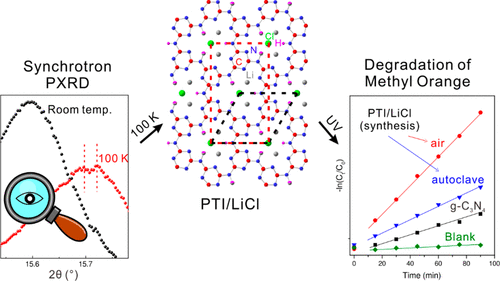当前位置:
X-MOL 学术
›
Inorg. Chem.
›
论文详情
Our official English website, www.x-mol.net, welcomes your
feedback! (Note: you will need to create a separate account there.)
Unraveling the Structure of the Poly(triazine imide)/LiCl Photocatalyst: Cooperation of Facile Syntheses and a Low-Temperature Synchrotron Approach.
Inorganic Chemistry ( IF 4.3 ) Pub Date : 2019-11-13 , DOI: 10.1021/acs.inorgchem.9b02287 Chang-Zhong Liao,Vincent Wing-Hei Lau,Minhua Su,Shengshou Ma,Chengshuai Liu,Chung-Kai Chang,Hwo-Shuenn Sheu,Jiliang Zhang,Kaimin Shih
Inorganic Chemistry ( IF 4.3 ) Pub Date : 2019-11-13 , DOI: 10.1021/acs.inorgchem.9b02287 Chang-Zhong Liao,Vincent Wing-Hei Lau,Minhua Su,Shengshou Ma,Chengshuai Liu,Chung-Kai Chang,Hwo-Shuenn Sheu,Jiliang Zhang,Kaimin Shih

|
Graphitic carbon nitride (g-C3N4)-based materials have attracted interdisciplinary attention from many fields. However, their crystal structures have not yet been described well. Poly(triazine imide)/LiCl (PTI/LiCl) of good crystallinity synthesized from salt melts enables a confident structural solution for a better understanding of g-C3N4-based materials. In this study, we synthesize PTI/LiCl of high crystallinity in air without byproducts and confirm the orthorhombic feature, which is not observed in powder X-ray diffraction (PXRD) patterns at room temperature, by employing low-temperature synchrotron PXRD. Together with spectroscopic techniques (X-ray photoelectron spectroscopy, solid-state nuclear magnetic resonance, and Fourier-transform infrared/Raman), the orthorhombic structure (space group Cmc21, No. 36) was determined and found to be a superstructure of the previously reported hexagonal structure, as confirmed by electron diffraction. The temperature-dependent synchrotron PXRD data also reveal a highly anisotropic expansion. This work also shows the much higher activity of PTI/LiCl than of g-C3N4 for the photocatalytic degradation of methyl orange under ultraviolet irradiation, especially so for PTI/LiCl with a densely packed (001) plane. This study demonstrates the structural complexity of the g-C3N4 class of materials and illustrates how their temperature-dependent anisotropies facilitate the discovery of the structural features in resolving the structure of g-C3N4-related materials and their structure-property relationship.
中文翻译:

揭开聚三嗪酰亚胺/ LiCl光催化剂的结构:轻松合成和低温同步加速器方法的合作。
石墨碳氮化物(g-C3N4)基材料已吸引了许多领域的跨学科关注。然而,它们的晶体结构尚未被很好地描述。由盐熔体合成的具有良好结晶度的聚(三嗪酰亚胺)/ LiCl(PTI / LiCl)可提供令人信服的结构解决方案,以更好地理解基于g-C3N4的材料。在这项研究中,我们在空气中合成了高结晶度的PTI / LiCl,没有副产物,并通过使用低温同步加速器PXRD证实了在室温下粉末X射线衍射(PXRD)模式中未观察到的正交晶体特征。结合光谱技术(X射线光电子能谱,固态核磁共振和傅立叶变换红外/拉曼光谱),正交结构(空间群Cmc21,No。如通过电子衍射所证实的,确定36)是先前报道的六边形结构的上层结构。随温度变化的同步加速器PXRD数据还显示出高度各向异性的膨胀。这项工作还表明,PTI / LiCl在紫外线照射下对甲基橙的光催化降解活性比g-C3N4高得多,尤其是对于具有密集堆积(001)平面的PTI / LiCl。这项研究证明了g-C3N4类材料的结构复杂性,并说明了它们的温度依赖性各向异性如何促进解析g-C3N4相关材料的结构及其结构-性质关系的结构特征的发现。随温度变化的同步加速器PXRD数据还显示出高度各向异性的膨胀。这项工作还表明,PTI / LiCl在紫外线照射下对甲基橙的光催化降解活性比g-C3N4高得多,尤其是对于具有密集堆积(001)平面的PTI / LiCl。这项研究证明了g-C3N4类材料的结构复杂性,并说明了它们的温度依赖性各向异性如何促进解析g-C3N4相关材料的结构及其结构-性质关系的结构特征的发现。随温度变化的同步加速器PXRD数据还显示出高度各向异性的膨胀。这项工作还表明,PTI / LiCl在紫外线照射下对甲基橙的光催化降解活性比g-C3N4高得多,尤其是对于具有密集堆积(001)平面的PTI / LiCl。这项研究证明了g-C3N4类材料的结构复杂性,并说明了它们的温度依赖性各向异性如何促进解析g-C3N4相关材料的结构及其结构-性质关系的结构特征的发现。特别是对于具有密集堆积(001)平面的PTI / LiCl。这项研究证明了g-C3N4类材料的结构复杂性,并说明了它们的温度依赖性各向异性如何促进解析g-C3N4相关材料的结构及其结构-性质关系的结构特征的发现。特别是对于具有密集堆积(001)平面的PTI / LiCl。这项研究证明了g-C3N4类材料的结构复杂性,并说明了它们的温度依赖性各向异性如何促进解析g-C3N4相关材料的结构及其结构-性质关系的结构特征的发现。
更新日期:2019-11-13
中文翻译:

揭开聚三嗪酰亚胺/ LiCl光催化剂的结构:轻松合成和低温同步加速器方法的合作。
石墨碳氮化物(g-C3N4)基材料已吸引了许多领域的跨学科关注。然而,它们的晶体结构尚未被很好地描述。由盐熔体合成的具有良好结晶度的聚(三嗪酰亚胺)/ LiCl(PTI / LiCl)可提供令人信服的结构解决方案,以更好地理解基于g-C3N4的材料。在这项研究中,我们在空气中合成了高结晶度的PTI / LiCl,没有副产物,并通过使用低温同步加速器PXRD证实了在室温下粉末X射线衍射(PXRD)模式中未观察到的正交晶体特征。结合光谱技术(X射线光电子能谱,固态核磁共振和傅立叶变换红外/拉曼光谱),正交结构(空间群Cmc21,No。如通过电子衍射所证实的,确定36)是先前报道的六边形结构的上层结构。随温度变化的同步加速器PXRD数据还显示出高度各向异性的膨胀。这项工作还表明,PTI / LiCl在紫外线照射下对甲基橙的光催化降解活性比g-C3N4高得多,尤其是对于具有密集堆积(001)平面的PTI / LiCl。这项研究证明了g-C3N4类材料的结构复杂性,并说明了它们的温度依赖性各向异性如何促进解析g-C3N4相关材料的结构及其结构-性质关系的结构特征的发现。随温度变化的同步加速器PXRD数据还显示出高度各向异性的膨胀。这项工作还表明,PTI / LiCl在紫外线照射下对甲基橙的光催化降解活性比g-C3N4高得多,尤其是对于具有密集堆积(001)平面的PTI / LiCl。这项研究证明了g-C3N4类材料的结构复杂性,并说明了它们的温度依赖性各向异性如何促进解析g-C3N4相关材料的结构及其结构-性质关系的结构特征的发现。随温度变化的同步加速器PXRD数据还显示出高度各向异性的膨胀。这项工作还表明,PTI / LiCl在紫外线照射下对甲基橙的光催化降解活性比g-C3N4高得多,尤其是对于具有密集堆积(001)平面的PTI / LiCl。这项研究证明了g-C3N4类材料的结构复杂性,并说明了它们的温度依赖性各向异性如何促进解析g-C3N4相关材料的结构及其结构-性质关系的结构特征的发现。特别是对于具有密集堆积(001)平面的PTI / LiCl。这项研究证明了g-C3N4类材料的结构复杂性,并说明了它们的温度依赖性各向异性如何促进解析g-C3N4相关材料的结构及其结构-性质关系的结构特征的发现。特别是对于具有密集堆积(001)平面的PTI / LiCl。这项研究证明了g-C3N4类材料的结构复杂性,并说明了它们的温度依赖性各向异性如何促进解析g-C3N4相关材料的结构及其结构-性质关系的结构特征的发现。

































 京公网安备 11010802027423号
京公网安备 11010802027423号